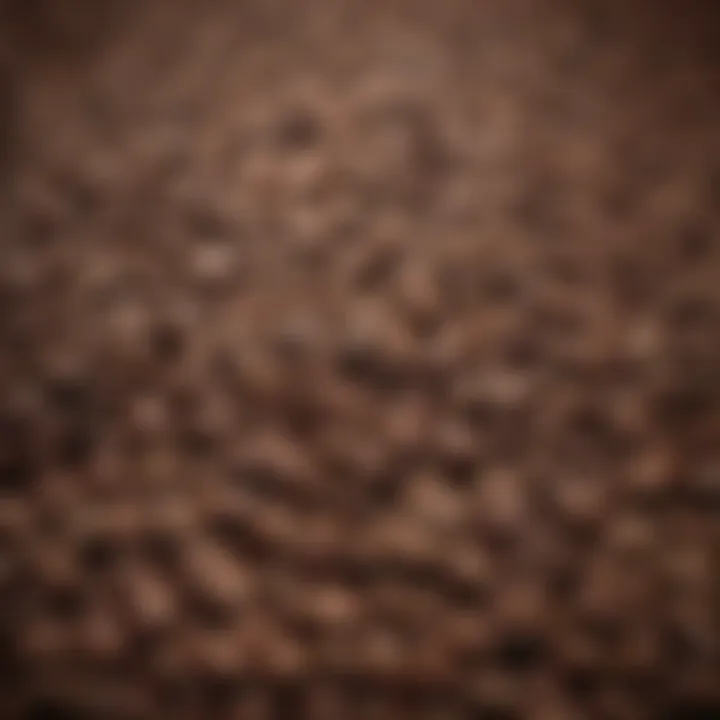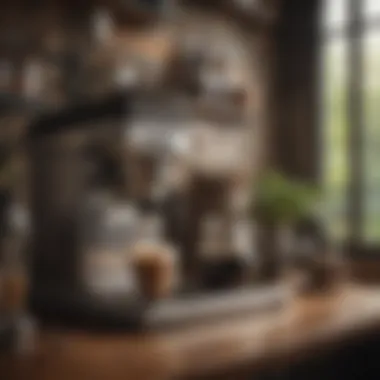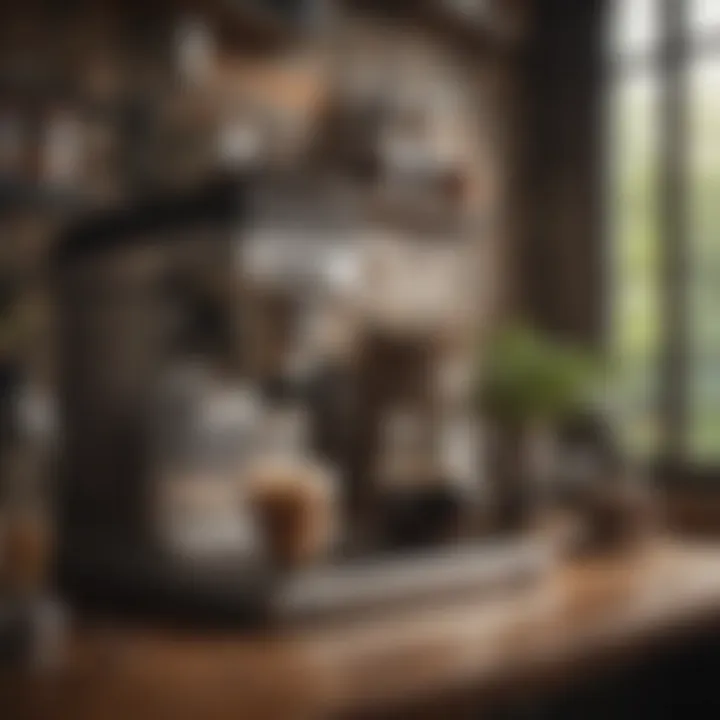Mastering the Art of Coffee Grind and Brew


Intro
Coffee is more than just a beverage; it is a ritual, an experience. Understanding how to achieve the optimal grind and brew can dramatically influence the flavor and aroma of your cup. This article delves into the intricate details of coffee grinding and brewing techniques. It offers insights into the various grind sizes and brewing methods, ensuring that both new and experienced coffee drinkers can enhance their daily habits.
The importance of grind size cannot be overstated. It affects the rate of extraction, which ultimately determines the taste of the coffee. The article will also highlight important brewing techniques, as well as the equipment options available to users.
Design Inspiration
The design of a coffee-making space can enhance the overall experience. A well-planned setup invites users to engage more fully with the process of brewing coffee. Consideration for both aesthetics and functionality can lead to a more enjoyable coffee ritual.
Trending Styles
Many coffee enthusiasts are leaning towards minimalistic designs that emphasize the beauty of simplicity. Equipment in neutral colors often complements kitchen spaces while ensuring that the coffee-making process remains the focal point. Some trending styles include:
- Industrial: Exposed elements, such as pipes and stainless steel, create a rugged feel while providing functionality.
- Scandinavian: Clean lines and light woods focus on functionality and warmth.
- Mid-century Modern: Retro designs combine form and function, adding a touch of nostalgia.
Color Palettes
The right color palette can evoke mood and enhance enjoyment. Common choices in coffee spaces include:
- Earth tones: Soft browns and greens simulate the natural coffee environment.
- Neutral colors: Whites and grays create a calm, clean look.
- Accent colors: Deep reds or blues can introduce energy and contrast.
Practical Tips
Maximizing your coffee experience involves more than just equipment choices. Proper maintenance and budgeting play essential roles.
Maintenance & Care
Keeping your coffee equipment clean is critical for optimal flavor. Regular cleaning prevents residue buildup that can affect taste. Here are practical tips:
- Clean grinders weekly to remove coffee dust.
- Descale coffee makers regularly to maintain efficiency.
- Store beans in airtight containers away from light and moisture.
Budgeting & Planning
Investing in quality coffee equipment might have a higher upfront cost but can lead to savings over time. Here are suggestions for planning your coffee budget:
- Research equipment options thoroughly before buying.
- Consider purchasing used or refurbished items to reduce costs.
- Plan a monthly coffee budget for beans and other supplies.
"The journey of coffee from bean to cup is as enriching as the beverage itself."
Understanding the nuances of grinding and brewing coffee allows for greater appreciation of this beloved drink. From design to practical tips, each aspect contributes to the ultimate coffee experience.
Prelude to Coffee Grind and Brew
Coffee, in its myriad forms, serves a significant role in the daily routines of many. Understanding the interplay between grind and brew is essential for anyone aiming to elevate their coffee experience. The two elements are interconnected; they influence each other and ultimately determine the quality of the final cup.
Proper grinding and brewing techniques can maximize flavor extraction, highlighting the nuanced characteristics of the beans. This knowledge is beneficial not only for coffee enthusiasts but also for casual drinkers who may be interested in improving their coffee taste.
Importance of Grind and Brew
Grind size affects the extraction process during brewing. If the grind is too fine, over-extraction may occur, leading to a bitter flavor. Conversely, a coarse grind might result in under-extraction, yielding a weak brew. Therefore, the right balance is crucial for achieving the desired flavor profile.
In addition, the method of brewing also matters. Different brewing methods require specific grind sizes to enhance the overall taste. For instance, a French press thrives on coarser grounds, while an espresso machine demands finely ground coffee. Therefore, mastering both grind and brew can significantly influence your coffee-making practice and the appreciation of coffee itself.
Historical Context of Coffee Preparation
The practice of coffee preparation has a rich history that dates back centuries. Initially, coffee beans were boiled in water to create a beverage, a method used in ancient cultures. This simple approach has evolved significantly.
By the 15th century, Middle Eastern cultures began to develop brewing techniques that utilized grounds. In Europe, the coffeehouse movement emerged in the 17th century, introducing a more social aspect to coffee consumption. The invention of machines and grinders has continually shaped the preparation process, leading to the numerous options available today.
Each method carries its historical significance and cultural context. For instance, the French press, with origins linked to early coffee brewing innovations, emphasizes a full-bodied taste, while espresso machines reflect a more modern approach to coffee preparation. Understanding this background enhances our appreciation of coffee and the varied experiences associated with it.
Understanding Coffee Grind Sizes
Understanding coffee grind sizes is crucial to achieving the optimal flavor and aroma in your brew. The grind size of coffee beans significantly affects how water extracts flavors during the brewing process. When the grind is too coarse, the water flows too quickly through the grounds, leading to under-extraction. Conversely, a grind that is too fine can result in over-extraction, causing bitterness in the final cup. Thus, knowing how to correctly select and manipulate grind sizes is essential for any coffee lover.
Grind sizes can be categorized as coarse, medium, and fine. Each type serves distinct brewing methods and influences the final taste. Enjoying coffee begins with understanding these grind sizes and their specific applications. Correctly matching your grind size to your brewing method can amplify the tasting experience.
Coarse Grind: Characteristics and Applications
A coarse grind consists of large chunks of coffee, similar to breadcrumbs. This size is often used for brewing methods that require longer contact time between the coffee grounds and water, such as the French press or cold brew techniques.
Applications of coarse grind:
- French Press: The coarse particles allow for immersion brewing, making a rich and full-bodied cup.
- Cold Brew: This method requires longer steeping times, where a coarse grind prevents over-extraction and bitterness.
Coarse grind is ideal for slow brewing processes. It allows for maximum flavor extraction without overwhelming the palate.


Medium Grind: Balanced Flavor Extraction
Medium grind is a versatile option, suitable for a range of brewing methods. It has a consistency resembling granulated sugar. This size permits a balanced extraction process, making it widely used for drip coffee makers and pour-over brews. Such a grind size maximizes flavors and aromas effectively.
Applications of medium grind:
- Drip Coffee Makers: Many automatic machines function best with medium grind, producing a well-rounded coffee.
- Pour Over: It enables better control over water flow and extraction time.
A medium grind strikes a balance between speed and flavor, making it a popular choice among coffee enthusiasts.
Fine Grind: For Intense Brews
Fine grind is characterized by its powdery texture, akin to table salt. This size is best suited for brewing methods that employ pressure or require quick extraction, such as espresso or AeroPress. The fine particles allow for a rapid release of flavor compounds, resulting in a more intense taste.
Applications of fine grind:
- Espresso Machines: The high pressure necessitates a fine grind for optimal flavor extraction quickly.
- AeroPress: This method benefits from finer grounds, allowing for a rich and concentrated brew.
Utilizing the appropriate grind size tailored to specific brewing methods can vastly change the flavor profile of the final cup of coffee. Therefore, it is essential to understand these distinctions and experiment to find the preferred grind that complements one’s brewing technique.
Brewing Methods Overview
Brewing methods are a critical element in the coffee-making process. They influence not just the flavor but also the overall experience of drinking coffee. Various brewing techniques cater to different tastes, equipment availability, and personal preferences. Understanding the intricacies of each method allows coffee enthusiasts to optimize their brewing routines and achieve a higher quality cup of coffee. Each brewing method emphasizes unique qualities of the coffee, highlighting the need for careful consideration.
Drip Coffee Makers: Convenience vs. Quality
Drip coffee makers are perhaps the most popular choice in homes and offices. Their convenience is unmatched. You simply add water, coffee grounds, and press a button. Many models are designed with programmable features that allow you to wake up to fresh coffee. However, the trade-off is often in the quality of extraction.
Drip coffee makers typically use paper filters which can absorb some of the oils that contribute to flavor texture. This can lead to a more muted taste compared to other methods. It is important to choose high-quality beans and the right grind size for the best results. To improve drip coffee's taste, using freshly ground coffee and maintaining the machine are essential steps.
French Press: Emphasizing Full-Bodied Flavor
The French press is celebrated for its ability to extract rich and full-bodied flavors from coffee beans. This method involves steeping coarsely ground coffee in hot water for several minutes. Once steeping is complete, a plunger pushes down a metal or nylon mesh filter, which separates the grounds from the beverage. Utilizing this process brings out the oils and fine particles in the coffee, enhancing mouthfeel and depth.
When making coffee with a French press, water temperature and steeping time are crucial. Typically, water should be slightly below boiling point, around 200°F (93°C). The common steeping time of four to five minutes prevents over-extraction, which can lead to bitterness. It is also important to experiment with different coffee-to-water ratios for optimal strength.
Pour Over: Precision and Control
Pour-over brewing offers precision and control over the coffee-making process. This method involves pouring hot water over coffee grounds in a slow, controlled manner. By allowing the water to bloom—where coffee grounds expand as they release gases—flavors are more fully extracted. Equipment like the Hario V60 or Chemex are popular choices for pour-over brewers.
One advantage of pour-over is the ability to control variables, including water temperature, flow rate, and brew time. This method allows for greater experimentation, enabling coffees to shine in individual characteristics. However, achieving the perfect cup may require more skill and attention—the art of pouring steadily is key.
Espresso Machines: The Art of Pressure Brewing
Espresso machines are specifically designed to brew coffee under pressure. A small amount of water is forced through finely-ground coffee at high pressure, resulting in a concentrated shot of coffee. Espresso is the foundation for many coffee drinks like lattes and cappuccinos.
Brewing espresso requires careful calibration of grind size, water temperature, and pressure. The ideal shot should take around 25 to 30 seconds to brew. Any deviation can affect taste significantly. This method emphasizes the intricacies of coffee flavor and bean characteristics, making it both an art and a science. Mastering espresso brewing opens up a world of complexity in coffee preparation.
Choosing the Right Coffee Grinder
Choosing the right coffee grinder is crucial for achieving optimal flavor in your coffee. The grind size influences how well the coffee extracts during brewing. An uneven grind can lead to over-extraction or under-extraction. Both of these result in poor flavor. Homeowners and coffee enthusiasts need to consider the type of grinder that suits their brewing method and personal preferences. The objective is not just to grind beans but to do it with precision. A suitable grinder enhances the quality of the coffee experience significantly, making it a vital aspect of the preparation process.
Blade Grinders: Pros and Cons
Blade grinders are popular for their affordability and ease of use. They feature a simple design comprising two blades that chop the beans into inconsistent sizes. This leads to varied extraction rates, which can adversely affect the flavor.
Pros:
- Cost-effective: Blade grinders are often the cheapest option available.
- Compact design: They take up little space, ideal for small kitchens.
Cons:
- Inconsistent grind: The inconsistent particle size can cause uneven extraction.
- Heat generation: The blades can produce heat, which negatively impacts the flavor of the coffee due to the loss of essential oils.
For those who prioritize budget and convenience, blade grinders may be suitable. However, for individuals seeking optimal flavor, it often lacks the required precision.
Burr Grinders: Uniformity in Grind Size
Burr grinders provide a superior option for grinding coffee. They use a pair of revolving abrasive surfaces to crush the beans, allowing for a more uniform grind size. This consistency is critical when it comes to brewing methods that require specific grind sizes.
Advantages of burr grinders include:
- Uniformity: Burr grinders ensure similar particle sizes, leading to balanced extraction rates.
- Better flavor: The minimal heat produced during grinding preserves the coffee's natural oils and flavors.
Investing in a quality burr grinder can significantly elevate the coffee-making experience, making every cup distinct and enjoyable.
Manual vs. Electric Grinders


The choice between manual and electric grinders comes down to personal preference and lifestyle. Manual grinders require physical effort but offer a sense of control over the grind size.
Manual grinders:
- Control: Users can adjust grind size more precisely.
- Portability: They are typically lighter and easier to transport.
- No electricity needed: Useful in places without access to power.
Electric grinders:
- Convenience: Grinding is faster and often more consistent.
- Variety: Many models come with different settings for grind size.
- Ease of use: Ideal for those who do not want to put in extra effort.
Ultimately, the right grinder will depend on factors such as daily routine, coffee consumption habits, and the importance placed on precision. Investing time in understanding these options will undoubtedly lead to a more satisfying coffee experience.
"The grind is the foundation of the brew. Without the right dimensions, the flavor will never reach its potential."
In summary, selecting the right coffee grinder plays a critical role in your entire coffee preparation routine. Take the time to evaluate your options to enhance your brew significantly.
Water Quality and Temperature
Influence of Water on Flavor
Water is often considered an overlooked ingredient in coffee preparation. However, it constitutes approximately 98% of a brewed cup of coffee. This high ratio emphasizes the need for quality water to ensure the best extraction of flavors. Different water types can yield vastly different results.
- Mineral Content: The mineral composition of water plays a crucial role. High mineral content can enhance the sweet and creamy properties of coffee, while low mineral water can result in a flat taste. Ideally, water should have some minerals, such as calcium and magnesium, which assist in the extraction of aromatic compounds.
- pH Levels: The acidity or alkalinity of water affects how well the coffee flavors are extracted. Water with a neutral pH, around 7, is generally optimal for coffee brewing. Water that is too acidic or too alkaline may accentuate some undesirable flavors while suppressing others.
- Filtered vs. Tap Water: Using filtered water is recommended to remove impurities found in tap water. Chlorine and other contaminants can negatively affect the taste of coffee. A good filter can help in improving both the flavor and aroma of the final brew.
"The quality of water used in brewing coffee is as important as the coffee beans themselves."
Optimal Brewing Temperature Range
Temperature is another critical factor in achieving the perfect blend of flavors in coffee. The recommended brewing temperature typically falls between 195°F to 205°F (90°C to 96°C). This range is optimal for capturing the full potential of the coffee grounds.
- Too Hot: Brewing at temperatures above 205°F can lead to over-extraction, which results in a bitter taste. The delicate aromas and sweet notes can also be lost at excessive temperatures.
- Too Cold: Conversely, using water that is too cool, below 195°F, can result in under-extraction. This will produce a weak and sour cup, lacking the depth of flavor that coffee is meant to offer.
- Brewing Techniques: The chosen brewing method can also influence the necessary temperature. For instance, espresso requires higher temperatures for proper extraction, whereas a French press may tolerate slightly cooler water.
To conclude, attention to water quality and temperature is essential for achieving an ideal coffee grind and brew experience. By considering these factors, one can ensure a more flavorful and satisfying cup of coffee.
The Role of Coffee Beans
Coffee beans are the essence of the beverage. Their selection and quality substantially influence the final taste of your brew. Understanding the role of coffee beans in the grind and brew process aids enthusiasts in making informed choices that resonate with their flavor preferences.
Single-Origin vs. Blends
When choosing coffee beans, one must consider whether to opt for single-origin or blended varieties. Single-origin beans come from one location, such as a specific farm or region. This often results in a unique flavor profile indicative of the region’s soil, climate, and farming methods. For example, Ethiopian coffee is known for its floral and citrus notes, while Colombian beans are often described as smooth and well-balanced. Knowing these characteristics guides a consumer to choose a brew that matches their palate.
On the other hand, blends combine beans from multiple origins. The goal is to create a harmonious flavor that balances the strengths and weaknesses of various beans. A well-crafted blend can offer complexity without the intensity of single-origin beans. Some prefer blends for their adaptability. They can suit different brewing methods more easily, allowing for more versatility in taste.
Freshness and Roast Dates
Another essential factor in the role of coffee beans is freshness. Coffee begins to lose its flavor soon after roasting. Ideally, consumers should purchase beans with a roast date clearly marked on the packaging. Freshly roasted coffee typically has a better aroma and taste. Factors such as storage and exposure to air can further diminish quality.
Moreover, the age of the roast also impacts how a brew evolves over time. Most experts recommend consuming beans within two to four weeks after the roast date for optimal quality. This ensures the flavors are at their peak, thus enhancing the overall coffee experience.
"Quality coffee begins with the right beans, fresh from the roaster. Without attention to these details, the perfect grind and brew are futile."
Understanding the significance of coffee beans, their origins, freshness, and roast dates allows enthusiasts to appreciate and enjoy their brew more profoundly. It is not merely about grinding and brewing but about selecting the right foundation for what will ultimately be enjoyed in the cup.
Experimenting with Ratios and Exposure Time
Experimenting with the right ratios and exposure time is a critical element in the coffee brewing process. It allows enthusiasts to tailor their coffee to suit both personal preferences and the specific characteristics of different coffee beans. Getting these two components right can significantly enhance or detract from the flavor profile of the brew.
The brew ratio refers to the amount of coffee used in relation to the volume of water. A common guide is the golden ratio of 1:15, which means one part coffee to 15 parts water. However, this can vary based on factors such as the type of coffee, the desired strength, and even the brewing method used. Understanding these ratios helps in achieving the balance needed for a satisfactory cup.
Understanding Brew Ratios
When examining brew ratios, there are a few important aspects to consider. First, the strength of the coffee will change depending on how much coffee grounds you use compared to the water. For instance, using more coffee will result in a bolder flavor, while less coffee might produce a more diluted taste.
Some scenarios that might require you to adjust the brew ratio include:
- Personal Preference: Taste varies among individuals. Adjusting the brew ratio can create a cup that aligns more closely with one's flavor preferences.
- Type of Coffee: Different beans have unique flavor properties. Experimenting with ratios can help highlight those qualities.
- Brewing Method: Different methods may require adjustments in the brew ratio. For instance, French Press might benefit from a stronger coffee, while pour-over might be better with a lighter brew.
Common Brewing Ratios
- 1:15 for standard drip coffee
- 1:10 for espresso-based drinks
- 1:18 for French Press
Importance of Brew Time
Brew time is equally important as it influences extraction differentials in coffee. This process refers to how long water interacts with coffee grounds. Too little time often leads to weak coffee which lacks depth, while too much time can lead to bitterness due to over-extraction of soluble compounds.
The optimal brew time varies depending on brewing methods. Here are some general guidelines:


- Drip Coffee Makers: 4-6 minutes
- French Press: 4 minutes
- Pour Over: 2-4 minutes
- Espresso: 25-30 seconds
Monitoring brew time is crucial. The goal is to reach the balance where flavors bloom without excess bitterness. Frequent experimentation with both brew ratios and exposure times is recommended. Adjustments based on flavor notes, strength desired, and brewing method serve as key drivers to perfect your coffee brewing practice.
"Achieving the perfect coffee requires attention to details like ratios and brew time, influencing overall flavor and experience."
By working on these elements, you not only enhance your brewing skills but also deepen your appreciation for the intricate art of coffee making.
Troubleshooting Common Issues
In the journey to achieve the perfect cup of coffee, encountering issues is quite common. Troubleshooting these problems plays a crucial role in refining the brewing process. This section looks at two persistent issues: bitter or sour coffee and weak brews. Understanding the causes and finding solutions can elevate one’s coffee experience significantly.
Bitter or Sour Coffee: Causes and Solutions
Bitter or sour coffee can arise from several factors. The quality of beans, the grind size, and brewing time are central to this phenomenon. Here are some common causes and their respective solutions:
- Over-extraction: If coffee grounds are steeped for too long, they release undesirable bitter compounds. This often occurs when using fine grinds for longer brewing methods.
- Under-extraction: On the flip side, under-extraction leads to sour notes. This can happen with coarse grinds in a quick brewing method, where not enough of the bean's essence is extracted.
- Equipment temperature: Brewing at too high a temperature can enhance bitterness, while too low can result in sourness.
- Solution: Try reducing the brewing time or using a coarser grind.
- Solution: Either extend the brewing time or use a finer grind.
- Solution: Ensure water temperature is between 195°F and 205°F (90°C - 96°C).
Identifying the right cause for bitter or sour coffee allows for fine-tuning the approach. Adjustments to brewing time and grind size can transform a disappointing cup into a delightful one.
Weak Brew: Adjustments to Consider
A weak brew can leave coffee lovers frustrated. This issue often stems from insufficient coffee grounds, too quick brewing times, or improper grind sizes. Below are key considerations and adjustments to improve brew strength:
- Coffee-to-water ratio: One of the most critical elements affecting strength is the coffee-to-water ratio. Utilizing too little coffee can lead to a diluted flavor.
- Grind size: If the grind is too coarse, it might not allow enough flavor extraction, resulting in a weak brew.
- Brew time: A quick brew can result in weak extraction, especially in a French press or pour-over method.
- Solution: A general starting point is using one to two tablespoons of coffee per six ounces of water.
- Solution: Experiment with a medium to fine grind, depending on the brewing method.
- Solution: Ensure steeping times are appropriate—around four minutes for a French press, for example.
Incorporating these adjustments can lead to richer flavors and a more satisfying coffee experience. Routine evaluation of brewing practices not only enhances flavor but also cultivates a deeper appreciation for coffee.
Coffee is an art; understanding its intricacies leads to mastery.
By addressing these common issues with informed strategies, coffee enthusiasts can nurture their passion and improve each brewing session.
Sustainable Practices in Coffee Preparation
Sustainable practices in coffee preparation address vital concerns surrounding environmental impact and resource management that have gained considerable traction in recent years. Coffee, as a global commodity, has a complex supply chain often associated with significant ecological footprints. When consumers become more aware of these factors, such sustainable choices enrich not only their personal coffee experience, but also contribute positively to the global environment. Fostering a mindset that prioritizes sustainability helps in ensuring the survival of coffee-producing ecosystems.
Implementing eco-friendly practices can mitigate harmful agricultural practices, minimize waste, and promote the consumption of ethically sourced products. Additionally, sustainability includes considering the entire lifecycle of coffee, from cultivation to preparation and consumption. These practices not only resonate with environmentally conscious consumers, but also create added value in the coffee experience.
Eco-friendly Coffee Choices
Selecting coffee that supports sustainability begins with choosing the right products. Single-origin coffees often provide transparency about farming practices, meaning buyers can trace their coffee straight to the source. Many farmers today adopt organic methods, avoiding harmful pesticides and fertilizers. Certifications such as Fair Trade, Rainforest Alliance, and USDA Organic signify that coffee is farmed using sustainable practices.
By prioritizing locally roasted and sourced coffee, consumers can also reduce the carbon footprint associated with transportation. Supporting local roasters promotes community growth and reduces the environmental costs linked with lengthy supply chains. Furthermore, consumers should consider coffee blends that emphasize ethical sourcing and environmentally aware farming practices.
Waste Minimization Techniques
Minimizing waste is crucial for sustainable coffee preparation. Simple actions, such as using a reusable coffee filter, can significantly cut down on single-use waste. Instead of relying on disposable pods or filters, investing in a high-quality metal or cloth filter is effective and practical.
In addition to reusable filters, blending leftover brewed coffee into various recipes can reduce waste. Coffee grounds themselves have multiple uses: they can serve as a natural fertilizer for gardens, as well as a deodorizer for refrigerators.
The End and Final Recommendations
In the world of coffee, achieving the optimal grind and brew experience is a nuanced endeavor. Throughout this article, we have explored various factors that play a crucial role in determining the quality of your coffee. From the grind size to the brewing methods, each element interacts to create a unique flavor profile. The importance of understanding these dynamics cannot be overstated, as they significantly influence not just the taste but also the overall brewing experience.
Specific elements to consider include the precision in grind size, as it affects extraction rates, and the choice of brewing method, which varies between delivering convenience or drawing out rich flavors. Investing in quality equipment, such as a burr grinder versus a blade grinder, can be a game changer. Additionally, water quality and freshness of the beans add another layer of depth to the brewing process. Choosing single-origin beans or appropriate blends impacts the final taste.
Benefits of mastering these aspects are manifold. A well-brewed cup of coffee enhances the sensory experience, boosting appreciation for this beloved beverage. For the homeowner or the occasional party host, the ability to create a superior coffee experience can impress guests and elevate gatherings. Moreover, being informed about sustainable practices in coffee preparation can lead to more environmentally conscious choices.
Considerations when applying the recommendations provided throughout this article should highlight personal preferences and openness to experimentation. As coffee brewing is as much an art as it is a science, one should not shy away from trial and error. Adapt techniques and methods to fit individual taste, ensuring each cup is not merely consumed but truly enjoyed.
Summary of Key Points
- Grind Size Matters: Coarse, medium, and fine grinds are suited for different brewing methods, affecting flavor and extraction.
- Brewing Technique Selection: Choices range from convenience in drip coffee makers to the precision of pour-over methods, influencing the final cup substantially.
- Quality of Ingredients: Freshness of coffee beans and purity of water play a crucial role in the final flavor profile.
- Sustainable Choices: Opting for eco-friendly coffee options and minimizing waste enhances both the coffee experience and environmental responsibility.
- Continuous Learning: Experimenting with grind sizes, brewing times, and ratios can lead to personal discoveries and better cups.
Encouragement for Further Exploration
Coffee is an expansive field, and while this article serves as a foundation, there exists a vast array of knowledge waiting to be discovered. Engage with local coffee communities through platforms like Reddit or community-centric Facebook groups to exchange insights and tips. Visit coffee tasting events, where you can appreciate diverse flavors and enhance your understanding of the craft.
Additionally, consider reading more about single-origin coffees or looking into the science of brewing through reputable sources like Wikipedia or Britannica. There are many great resources that delve into nuances like the chemical reactions during brewing or advanced roasting techniques.
Developing your skills in grinding and brewing can be a fulfilling journey. Embrace the learning process, stay curious, and enjoy the rewarding experience of crafting your perfect cup.















